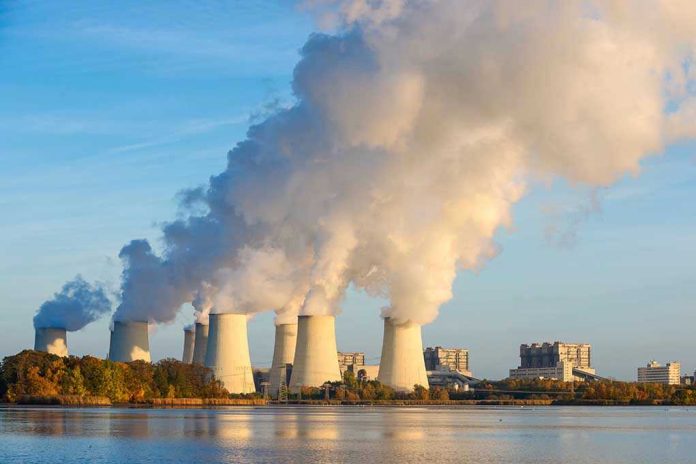
If you thought the bureaucratic circus around America’s energy independence couldn’t get any more absurd, wait until you see how Small Modular Nuclear Reactors—once touted as the next great leap in national security—have been tripped up by red tape and runaway costs, leaving America’s global leadership hanging by a thread.
At a Glance
- Small Modular Nuclear Reactors (SMRs) were promoted as a path to American energy dominance and security under President Trump.
- Despite historic technical breakthroughs, commercial SMR deployment remains stalled thanks to regulatory bottlenecks and ballooning costs.
- International rivals, including China and Russia, are racing ahead with their own SMR programs while America dithers.
- The future of U.S. nuclear leadership—and national security—now hinges on whether government can finally get out of its own way.
Trump’s Push for Nuclear Innovation Meets a Familiar Foe: Bureaucracy
President Trump entered office vowing to revive America’s nuclear sector, pushing for advanced technologies like Small Modular Nuclear Reactors to secure energy independence and national defense. The Department of Energy, under his direction, pumped billions into SMR research and development, with the Idaho National Laboratory and private companies like NuScale Power taking the lead. The plan was simple: build smaller, safer, and more flexible reactors that could be deployed quicker and at lower cost than the lumbering giants of the past. But the plan hit the all-too-familiar wall of government inertia and regulatory micromanagement. NuScale did succeed in getting the first-ever NRC approval for a commercial SMR design in 2022—a technical milestone. But when it came time to actually build the thing, costs spiraled, and the flagship Carbon Free Power Project was unceremoniously canceled in 2023. So much for streamlined innovation.
The Trump administration’s executive actions to accelerate approvals and cut red tape were met with little more than foot-dragging from entrenched regulators. The Nuclear Regulatory Commission, charged with ensuring reactor safety, managed to slow-walk new designs into oblivion, all while America’s strategic rivals in Beijing and Moscow charged ahead with their own SMR deployments. The message from D.C.? America can invent the future, but it can’t build it—not unless the paperwork gods smile upon us.
The Global Race: While America Naps, China and Russia Move In
While U.S. policymakers debate and delay, other nations are seizing the initiative. China, Russia, South Korea, and even some European firms are rolling out their own SMR designs, snapping up global contracts, and setting the standards that others will have to follow. America’s early lead, built on decades of research and billions of taxpayer dollars, is slipping away with every regulatory delay and canceled project. The world isn’t waiting for the NRC to finish another round of paperwork; they’re building, deploying, and exporting. The consequences for national security are obvious to everyone except, apparently, the bureaucrats: whoever controls the next generation of nuclear energy controls the future energy map—and America is in danger of ceding the field.
The economic impacts are equally damning. U.S. utilities that once lined up to buy American-made SMRs are now questioning whether the technology will ever become reality. The jobs, manufacturing, and geopolitical leverage that come with being the world’s nuclear supplier are at risk of being shipped overseas. It’s a textbook case of government overreach and mismanagement sabotaging American competitiveness in the name of “safety” and “process.”
Regulatory Paralysis: How Red Tape Threatens National Security
The real tragedy is that the technical promise of SMRs is undeniable. These reactors could provide clean, reliable energy to military bases, remote communities, and industrial facilities—fortifying America’s electric grid against both natural disasters and foreign threats. They could help decarbonize key sectors, create high-paying jobs, and put America back in the driver’s seat of global energy innovation. But instead of unleashing this potential, federal regulators have managed to bog the entire sector down in a swamp of endless reviews, contradictory standards, and sky-high compliance costs.
Critics will claim that “caution” is necessary after past nuclear mishaps, but what’s really at play here is a fundamental hostility to American innovation and a belief that government knows best—even when it produces nothing but delays and disappointment. As a result, U.S. national security is compromised, energy costs remain high, and the very future of American nuclear leadership is at stake. It’s hard not to see the irony: the same government that can’t keep the lights on or the borders secure now wants to micromanage the most important energy technology of the 21st century.
Sources:
Story Behind America’s First Potential Small Modular Reactor – U.S. Department of Energy
USA Nuclear Power – World Nuclear Association
Small Modular Nuclear Reactors: A History of Failure – Climate & Capital Media
Small Modular Reactor – Wikipedia
Small Modular Reactors: A Realist Approach to the Future of Nuclear Power – ITIF














